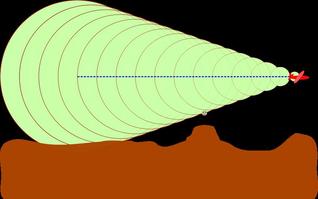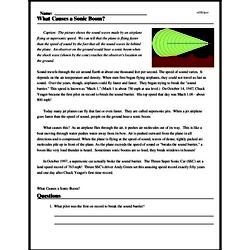What Causes a Sonic Boom?
Caption: The picture shows the sound waves made by an airplane flying at supersonic speed. We can tell that the plane is flying faster than the speed of sound by the fact that all the sound waves lie behind the plane. An observer on the ground would hear a sonic boom when the shock wave (shown by the cone) reaches the observer's location on the ground.
Sound travels through the air around Earth at about one thousand feet per second. The speed of sound varies. It depends on the air temperature and density. When men first began flying airplanes, they could not travel as fast as sound. Over the years, though, airplanes could fly faster and faster. They began trying to break the "sound barrier." This speed is known as "Mach 1." (Mach 1 is about 750 mph at sea level.) On October 14, 1947, Chuck Yeager became the first pilot on record to break the sound barrier. His top speed that day was Mach 1.06 - about 800 mph!
Today many jet planes can fly that fast or even faster. They are called supersonic jets. When a jet airplane goes faster than the speed of sound, people on the ground hear a sonic boom.




